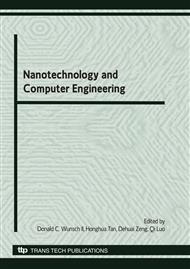[1]
A. Liu, F. Tendick, K. Cleary, and C.R. C.R. Kaufmann. A survey of surgical simulation: Applications, technology, and education. Presence: Teleoperators & Virtual Environments, 2003, 12(6): 599-614.
DOI: 10.1162/105474603322955905
Google Scholar
[2]
C. Basdogan, C-H. Ho, and M.A. Srinivasan. Simulation of Tissue Cutting and Bleeding for Laparoscopic Surgery Using Auxiliary Surfaces, Proceeding of medicine meets virtual reality, 1999, 38-44.
Google Scholar
[3]
V. Loup. Computer experiments on classical fluids, Physical Review, 1967, 159(1), 98-103.
Google Scholar
[4]
F.P. Preparata, and M. I. Shamos. Computational Geometry: An Introduction (Springer, 1985).
Google Scholar
[5]
T. H. Cormen, and C. E. Leiserson, Introduction to Algorithms (Massachusetts: The MIT Press, 2001).
Google Scholar
[6]
Joseph O'Rourke. Computational Geometry in C (Cambridge University Press, 1998).
Google Scholar
[7]
Houston. M, General-purpose computation on graphics hardware, Siggraph 2007 GPGPU course, http: /www. gpgpu. org/s2007.
DOI: 10.1145/3250714
Google Scholar
[8]
Jingsi Zhang, Lixu Gu, Pengfei Huang, and Jalda Dworzak, et al, Real Time Cutting and Suture Simulation Using Hybrid Elastic Model, Annual International Conference of the IEEE Engineering in Medicine and Biology, 2007, pp.3646-3649.
DOI: 10.1109/iembs.2007.4353121
Google Scholar
[9]
Provot, X. Deformation constraints in a mass-spring model to describe rigid cloth behavior. Proceedings of Graphics Interface'95, 1995, pp.141-155.
Google Scholar
[10]
Zhiyong Yuan, Qian Yin, Jun Hu, and Shikun Feng et al, Study on VR-Based Medical Image Deformation for Surgical Training System. Proceedings of the Fourth International Conference on Natural Computation, Vol. 5, Jinan, Shandong, China, October 18-20, 2008, pp.124-127.
DOI: 10.1109/icnc.2008.675
Google Scholar
[11]
NVIDIA Corporation. NVIDIA CUDA Compute Unified Device Architecture, Programming Guide. http: /developer. download. nvidia. com/compute/cuda/1_0/NVIDIA_CUDA_Programmin g_Guide_1. 0. pdf, (2007).
DOI: 10.2172/1532687
Google Scholar
[12]
Simon Green. NVIDIA CUDA FAQ Version 1. 0. http: /forums. nvidia. com/index. php? showtopic=36286, (2007).
Google Scholar
[13]
Mark, W., Glanville, R., Akeley, K., and Kilgard, M. 2003. Cg: A system for programming graphics hardware in a C-like language. In: ACM Computer Graphics (Proc. SIGGRAPH '03). pp.896-907.
DOI: 10.1145/1201775.882362
Google Scholar


